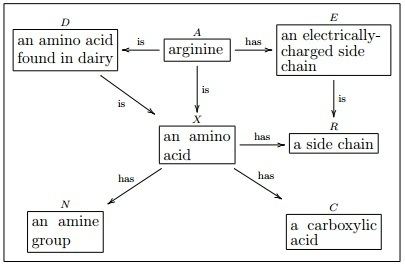 | ||
The theory of ologs is an attempt to provide a rigorous mathematical framework for knowledge representation, construction of scientific models and data storage using category theory, linguistic and graphical tools. Ologs were introduced in 2010 by David Spivak, a research scientist in the Department of Mathematics, MIT.
Contents
Etymology
The term "olog" is short for "ontology log". "Ontology" derives from onto-, from the Greek ὤν, ὄντος "being; that which is", present participle of the verb εἰμί "be", and -λογία, -logia: science, study, theory.
Mathematical formalism
At the basic level an olog
Every olog has a target category, which is taken to be
The boxes in the above example refer to objects of
For another example let
We can use
Ologs and databases
An olog
Relations between ologs
Communication between different ologs which in practice can be communication between different models or world-views is done using functors. Spivak coins the notions of a 'meaningful' and 'strongly meaningful' functors. Let
Taking as an example
We say that
Sometime it will be hard to find a meaningful functor
If communication between ologs is limited to a two-way communication as described above then we may think of a collection of ologs as nodes of a graph and of the edges as functors connecting the ologs. If a simultaneous communication between more than two ologs is allowed then the graph becomes a symmetric simplicial complex.
Rules of good practice
Spivak provides some rules of good practice for writing an olog whose morphisms have a functional nature (see the first example in the section Mathematical formalism). The text in a box should adhere to the following rules:
- begin with the word "a" or "an". (Example: "an amino acid").
- refer to a distinction made and recognizable by the olog's author.
- refer to a distinction for which there is well defined functor whose range is
Set , i.e an instance can be documented. (Example: there is a set of all amino acids). - declare all variables in a compound structure. (Example: instead of writing in a box "a man and a woman" write "a man
m and a womanw " or "a pair( m , w ) wherem is a man andw is a woman").
The first three rules ensure that the objects (the boxes) defined by the olog's author are well-defined sets. The fourth rule improves the labeling of arrows in an olog.
Applications
The concept was experimentally documented by David Spivak and coauthors Associate Professor Markus J. Buehler of the Department of Civil and Environmental Engineering (CEE) and CEE graduate student Tristan Giesa in a paper that was published in the December 2011 issue of BioNanoScience[2] in which the researchers establish a scientific analogy between spider silk and musical composition.
